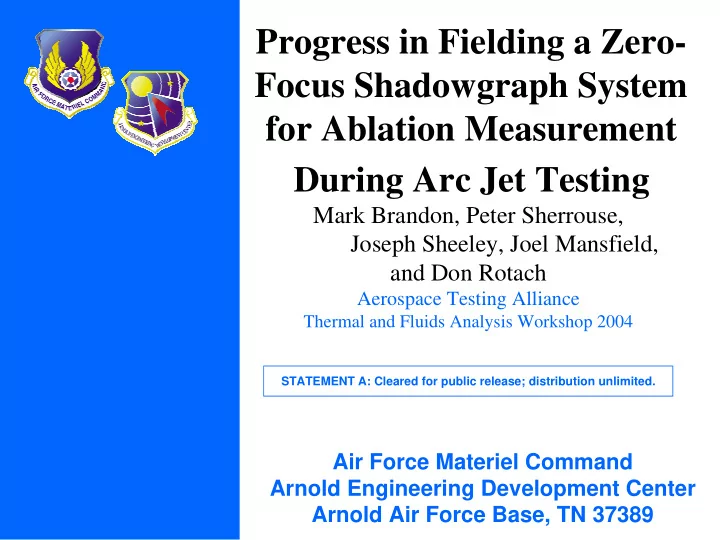

Progress in Fielding a Zero- Focus Shadowgraph System for Ablation Measurement During Arc Jet Testing Mark Brandon, Peter Sherrouse, Joseph Sheeley, Joel Mansfield, and Don Rotach Aerospace Testing Alliance Thermal and Fluids Analysis Workshop 2004 STATEMENT A: Cleared for public release; distribution unlimited. Air Force Materiel Command Arnold Engineering Development Center Arnold Air Force Base, TN 37389
Outline •Materials Testing in Arc Heated Tunnels •Facility Description •Issues - Motivation for New Technique •Shadowgraph Technique •Shadowgraph Images •Image Reduction Method •Conclusions
DOD Arc Heater Flight Simulation Envelope 300 Hypersonic Interceptor Lifting Body Reentry (Shuttle) Ascent (Typ.) PRESSURE ALTITUED, KFT 200 Maneuvering SCRamJet Reentry JSC & AMES ARCS Ascent 100 AEDC H2 AEDC H1 & H3 ICBM (Typ.) 2 4 6 8 10 12 14 16 18 20 22 24 SIMULATED VELOCITY, KFT/S 200 400 600 800 1000 2000 4000 6000 8000 10000 TOTAL ENTHALPY, BTU/LBM
Typical Tests Performed Scramjet Leading Edge Missile Nosetip Missile Nosetip Reentry Vehicle Reentry Nosetip Heat Shield Cooled Seeker Window Scramjet Leading Edge Missile Forebody
Schematic of HEAT H1 Facility
Film Reading Technique • Test article filmed during a run using split ND Filter • Film developed, lengths determined manually • Results typically available overnight Issues • Exposure, filtering, variances in test article brightness • Little feedback soon after test, difficult to make adjustments • Environmental issues
CCD/Image Analysis Technique • Record digital images using a CCD Camera • Use image analysis software to determine profiles and ablation rates immediately after test Advantages • Immediate feedback • Less labor intensive • No chemicals
Difficulties in Using Images/Self- Luminosity • Test article stagnation region extremely bright, washing out edges • Split ND filter, natural brightness variations cause many edges • Still have filtering issues due to variations in test article brightness
Standard Film Image of a Nosetip Test in H1
Proposed Solution : Zero Focus Shadowgraph • Laser backlighting creates silhouette of test article • Laser line filtered to eliminate self luminance • Resultant image has high contrast test article edges • Ideal for computer automated edge detection and tracking
Arc-Specific Issues - Solutions • Blocking of extreme test article incandescence – wavelength selection & “robust” filter design • Flow density gradients create severe vignetting – Large aperture system & reduced vignetting design • Radiant heat induced drift of filters – Front end IR blockers • “ Facility Smoke and Fire Tolerance ” – Facility hardened system design
Zero-focus Shadowgraph Configuration Nozzle Flow Beam expander Filter pack Laser Imaging lens Camera Flow field Test article
Receiver Assembly
Filter Temperature Shift
Zero-focus Shadowgraph of Nose-tip Test
Image Processing on Zero Focus Shadowgraph • Processing steps: – Setup the Image characteristics • Threshold levels • Area of interest • Process loop extremes • Image Inversion – Locate target pattern and determine leading edge – Calculate edge distance for each row and create shape Original Image Inverse with target Target Shape
Image Processing on Zero Focus Shadowgraph • Processing Complications – File Conversion • File had to be converted from the original AVI to a binary array in order to use standard programming techniques. Software based on LabVIEW™ from National Instruments™ (IMAQ image processing add-on toolkit) • LabVIEW™ conversion utilities were used to convert bitmap to data array – Non-Uniformity of Background • Optical artifacts in addition to bow-shock imagery caused problems setting a well defined target .vs. background threshold level. • An image inversion was performed prior to application of a Multi level threshold in order to convert original image to single bit image – Target Shape Definition • LabVIEW™ IMAQ toolkit provides a very useful pattern recognition tool. • Pattern recognition “highly” dependent on quality of imagery • Optimized optics on imager are needed in order to provide more defined target .vs. background contrast.
Image Processing on Zero Focus Shadowgraph • Sample movie showing image processing of typical test article.
Conclusions • Images of significant contrast were produced, suitable for image analysis • Preliminary image analysis has been applied • Capability to determine test article shape via automated analysis has been demonstrated • Technique has the potential to reduce turn-around time to support decisions during test matrix execution
Recommend
More recommend